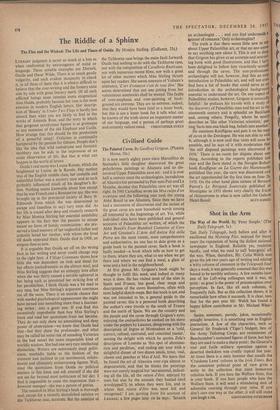Civilised Guide
IT is now nearly eighty years since Marcellino de Sautuola's little daughter discovered the great polychrome paintings at Altamira and so dis- covered Upper Palaeolithic cave art : and it is over half a century since the archeologists, incredulous of Altamira but persuaded by Pair-non-Pair andLa Mouthe, decided that Paleolithic cave art was all right. In 1901 Cartailhac wrote his Mea culpa d'un sceptique and the following year took the young Abbe Breuil to see Altamira. Since then we have had a succession of discoveries and the names of ' the great caves are now household words among all interestedin the beginnings of art. Yet, while individual sites have been published and general accounts of Paleolithic art written, of which the Abbe Breuil's Four Hundred Centuries of Cave Art and Graziosi's L'Arte dell'Antica Eta della Pietra are the most recent,. most comprehensive and authoritative, no one has to date given us a guide book to the painted caves. Such a book is badly needed—a book which tells us how to get to them, where they are, what to see when we get there and where we can find a meal, a glass of wine and a bed in the neighbourhood.
At first glance Mr. Grigson's book might be thought to fulfil this need, and indeed in many ways it does. He has visited most of the sites in Spain and France, has good, clear maps and descriptions of the caves themselves, often with most helpful sketch-maps. But this book is not, and was not intended to be, a general guide to the painted caves; this is a personal book describing the author's own travels to the south of France and the north of Spain. We see the country and the people and the caves through Grigson's eyes; enjoying the andouillettes he cooked on his stove under the poplars by Lascaux, disagreeing with his
description of Ingres at Montauban as a 'cold, correct, refined, castrated, and conceited master,' sensing the delight with which he quotes Zola's description of Lourdes as 'this spot of abomina- tion and perdition,' and ending -oar tour with a delightful dinner of two dozen snails, trout, veal, cheese and peaches at Mas d'Azil. We learn that he found the art of Altamira over-ripe almost to degeneration, and that he thinks the paintings were not merely magical but 'sacramental, indicat-
ing all the life, all the raison d'etre, enjoyed by men but also by the animals they hunted (and worshipped?), to whom they were kin, and in whom that raison d'etre was most felt and
recognised.' I am quoting from his account of Lascaux; a few pages later on he says: 'Scratch an archaeologist . . . and you find underneath a spinner of romance.' Only archeologists?
The truth is that there seems little new to say about Upper Palaeolithic art, or that no one seems to say anything new about it. This is not to denY that Grigson has given us an accurate and interest• ing book with good illustrations, and that I have been delighted to follow him vicariously around and through the caves. The non-professional archeologist will not, however, find this an easy introduction to Palaeolithic art, and will not even find here a list of books that could serve as an introduction to the archaeological background essential to understand the art. On one aspect of PalmollthiO studies, however, Grigson is unusuallY helpful : he prefaces his travels with a study of the discovery of Palaeolithic man and his art in the nineteenth century and is splendid on Buckland and, among others, Pengelly, whom he neatly describes as 'like other Victorian scientists,' put- ting 'facts into one black bag, beliefs into another.
He mentions Rouffignac and puts it on his map of caves in the Dordogne. He was not able to visit ' it, although it is now said that visits will soon he possible, and he says of it with moderation that `the still disputed paintings were discovered in 1956.' There is no room for dispute about one thing. According to the reports published last year and the facts stated in the Nougier-Robert book Rouffignac ou La Guerre des Mammouths published this year, the cave was discovered and the art apprehended for the first time on June 26, 1956. On the other hand plate sixteen of Bernard Pierret's Le Perigord Souterrain published at Montignac in 1953 shows very clearly the frieze of rhinoceroses in what is now called the Galeria


































 Previous page
Previous page